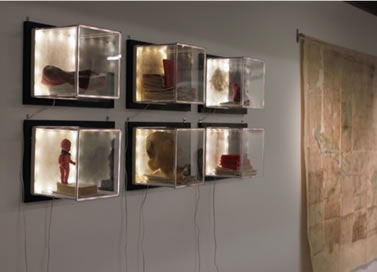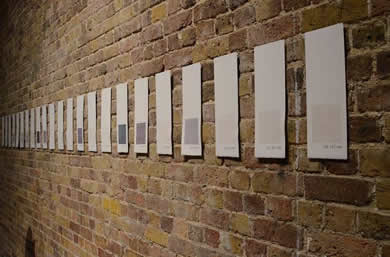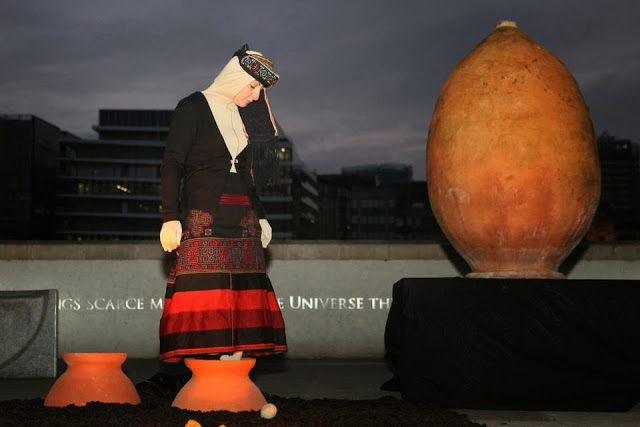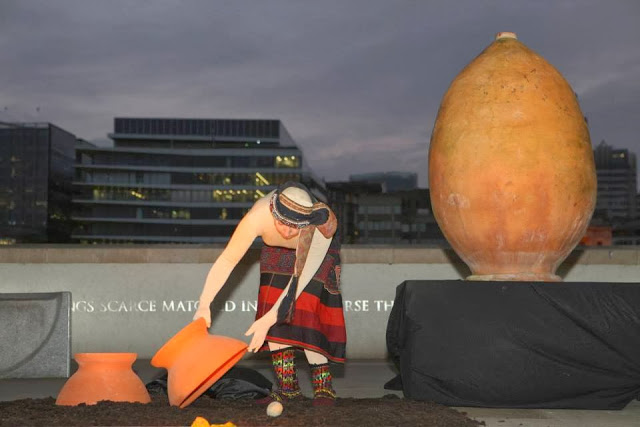Press
Multimedia Reflections on Georgian Heritage and Identity.

Levan Mindiashvili's work Archives depicts the mentality of the transitional generation, who were left to piece together an identity from an array of opposing influences, like that of the communist childhood and the Westernised present. "The way history was taught at Georgian schools, was always a mixture of morbid war details and adoration of death, fascination of battle and sacrificing your life for your country," comments Levan. "This image was so strong for me: red, blood, the person has to die for the country".
Click here to read the full article.
Review: “Wine Shades by the Eyes of a Colour Blind” by Kote Sulaberidze
You’d be hard pressed to find an equivalent. 60-70 portrait format rectangles of absorbent paper each stained with a 15cm wide horizontal rectangle of colour, displayed, serendipitously, on a wall of similarly-shaded, warm brickwork in London’s ‘wine-museum’, Vinopolis. The colours ranged from deep purples and grey-blues, to watery pinks, yellows, and off-whites, some so faint that they were scarcely perceptible on the white paper. These are the colours of Georgian wines – the basic distinction of red, white and rosé, delightfully exploded into a few of the millions of shades apparently distinguishable by the human eye and crystallised on paper by a process that the artist, Kote Sulaberidze, one of Georgia’s most distinguished, himself apologetically admitted “was more enjoyable than the end result”, in that not all of his raw materials reached the page.

It’s true that there was little to be gained from contemplating one panel from a distance and then in close up, or pondering the skill of the technique, or trying to find a developing narrative in circulating around the room, with a tall, folded ‘wine list’ in restaurant style in hand to identify these, to me, unknown wines. In truth there were not multiple works; this was one piece. The effect lay in the overall relaxing ambience of shades of muted colours, not of an artist’s choosing but, as it were, given by nature; muted and necessarily tonally related by their subject.
Not a subject they were depicting, though. The extracted, abstracted colours could scarcely get more impersonal if it were a colour chart in a Farrow & Ball showroom. And yet, all drawn from wine, they each, and as a whole, offered a window behind the flimsy sheets of blotting paper to a world of individuals and an ancient wine-loving culture. Talking with Georgians mingling at the opening one pointed out his favourite, everyday white that was the ‘best wine’, drunk as, well, everyday drink, never offending with a hangover. In contrast to the UK, in Georgia it’s white for men, reds for women, mainly. And slips of paper picked randomly let you know what the artist was doing whilst creating each panel, and presumably simultaneous having a tipple. And sooner or later the explanations came round to the Georgian supra or ‘tablecloth’, around which it seems familial, communal and national bonding takes place over wine. These were personal associations deeper than my affinity with Tesco’s Chilean Merlot. On a national cultural level Georgia and wine is a subject worth exploring. Maybe it’s the oldest wine-producing culture anywhere with an 8000-year history. Pleasing and curious enough in themselves, these plain colours were a door to something else much more open to discussion, which flowed naturally amongst the guests, glass in hand – art, food, culture, music, politics, current affairs. There were some ‘foreigners’ amongst the guests, but had there been more non-Georgians the door would have been opened many more times.
And yes, this work of art would be difficult to replicate. With what? Foodstuffs from the supermarket? The colours of melted Mars Bars? Shades of beer? The reds and greens of squashed tomatoes? I mean what? What else could have such variety of colour and variety of meaning as wine? And what wine could have such resonance as Georgian wine? The country’s mystery, relatively small size and age lend deeper meaning than could be extracted from the commercialised, internationalised Pinot Noirs and Sauvignon Blancs. Maybe the artist, having patented a way to commit the hues of a wine taster’s glass to paper could offer his services to the French, Italians, and, hey, South Africans to present their own wine-promoting exhibitions. But it would be to promote the wines themselves. This exhibition, innocent in its playfulness, was to promote the colour of wine.
So yes, the artist may have had a lot of pleasure in the process of making the work. But only imagination extends pleasure from a basic human need on the Maslowian scale to life-enhancing experience, and in having been privileged to see what must have been a unique and not-easily-repeatable artistic conception, the pleasure was, and continues to be, all mine.
The exhibition was organised by cARTveli – London based foundation to promote art from Georgia.
https://www.facebook.com/cartveliart
http://musicdeli.wordpress.com/2014/06/29/wine-shades-by-kote-sulaberidze/
‘I BELIEVE ONE CAN DEVELOP ANYWHERE GIVEN THEY WANT TO,BUT THE WAVELENGTH YOU DECIDE TO STAY ON DEPENDS ON YOU’-Elene Rakviashvili
Elene Rakviashvili’s performance commissioned by cARTveli Foundation was brought to London, first showing at the Georgian Christmas Fair and then at the White Cube, Mayfair.
Elene Rakviashvili, trained painter, works on performances, video art, photography, installation and public art. Based in Georgia, the focus of her art is the society and themes having a particular significance locally. Georgia is inexhaustible source of inspiration for the artist and according to her the environment is so complex, diverse and exciting she would never move to other countries. Elene has a very peculiar attitude towards life seeing all the obstacles and disadvantages as the challenges and actually key to her successful career in art. The first happening was also born out of the desperate reality of the 90s Tbilisi engulfed in fear of the ambiguous future. People exiting the underground (one of the few places having electricity) were taken by surprise seeing the brightly lit street with the images shining on the walls. Driven by the intense desire to cheer and give hope to the confused, disoriented and depressed mass, Elene was personally greeting everyone exiting the underground. More than 10 years after the first performance the artist jokes some of her friends still expect her to stop fooling around and start painting.
Academically trained, Elene has managed to escape its daunting restrictions and find herself as a performance artist. Instead of limiting her the artist says it has helped a lot when working in multimedia especially in terms of composition, teaching the discipline and accuracy, making her perceptive and diligent. Elene closely observes her surroundings and picks up on the most problematic issues. Her art revolves around the social themes, questions about identity, gender and tradition. Seeing the potential of art to change the whole epoch and the standpoint of the whole society, Elene fully understands the importance of its engagement with social questions. Disapproving the non-existent spirit of togetherness in the creative circles, the artist also does not like the local indifferent audience, who was way more receiving and participating in 90s.
Her art always draws parallels with the European values with the aim of resurfacing some of the most problematic aspects of Georgian mentality. She works and thinks a lot about broad concepts such as Georgian national identity, as well as specific historical events. The artist masterly incorporates the distinctive nature of Georgia, being at the crossroads of Asian and European cultures. In order to grasp the roots of some of the most perpetuating stereotypes and perceptions, she often time-travels with her art.
http://geoplatforma.blogspot.co.uk/2013/12/me-effort-to-follow-footprints.html
In the performance My effort to follow the footprints Elene in the national costume, hesitantly approaches the Qvevri, traditional wine making vessel, and tries to squeeze into one of them. In the process she takes off the clothes in order to accomplish the impossible task. Taking off the dress she is left in a plain, monochrome costume- faceless, uniform and boring compared to the national dress. Trying to somehow adjust the Qvevri, she breaks it. Then hugging the fragments she tries to get the pieces together. Finally comes the realisation- it is impossible to squeeze through the Qvevri or mend what has been broken. Regretting, with her head down, she ends the performance. It is quite characteristic for the Georgian society to incorporate the foreign habits into its environment flatly. It looks as forced, unnatural and illogical as trying to fit into a piece of pottery. The allegory of Qvevri is a clever choice, because usually very traditional and very distinctively Georgian customs go through these modifications. ‘The influence of the dominating countries has always been present in Georgia. However, a lot of things get lost in attempt to Europeanize the society- traditions, self-awareness, identity’- remarks the artist.
Ironically, Elene Rakviashvili belongs to the small group of Georgian artists who manage to maintain their distinctiveness and at the same time correspond to the European trends and developments in art; and this is so organic, not a bit is forced.
The performance was brought to London by the non-profit foundation ‘cARTveli'. The collective of Ekaterina Moniava, Elizabeth Chachkhiani and Tereza Kandelaki want to promote the Georgian contemporary art abroad. A product of their inexhaustible enthusiasm, it is a series of pop up shows concentrating on some of the most exciting names.


